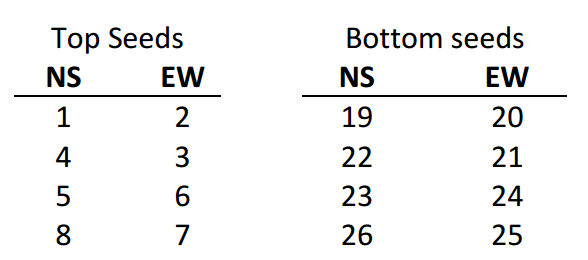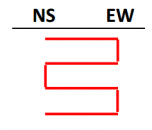- Home
- Results
- Tournaments
- WB Events
- Initiatives
- WBRC
- Resources
- Contact
- Search
Seeding players for bridge events
Why use seeding
Seeding a field for bridge (or any sport for that matter) is an attempt to even the field which
gives players an equal chance to win. It is not an exact science and players can play above
(or below) their ranking, but is the best attempt to have a fair competition. Each field of
play (eg the NS field or EW field) should be roughly equal in strength. To accomplish this, a
seeding committee or the director places the players in groups prior to an event or session,
so that approximately the same number of strong and weak players are in each field.
Generally speaking, events are not seeded unless for a major tournament where there are a
number of strong players present. However, this does not stop clubs seeding if they wish
to, especially for Championship events.
If a section is not balanced in strength, results can be skewed in favour of some and not
others. The point to remember is that the players are competing against those playing the
same section, not those playing against them. Therefore, if you have a NS field full of top
ranked players, they are competing against the other NS players. That field would be a very
competitive section, so scores are likely to be lower and closer. On the EW side, if all the
weaker players are playing in this section, they are only competing against weaker pairs, so
have a chance to score better or as well as the stronger players sitting NS. This is because
there are no strong players in their section to balance the results.
If you think about major sports events, they always seed players. What they do is place the
top 2 ranked players at opposite ends of the draw, so they do not meet each other until well
into the event (if at all). The remaining seeds are distributed evenly in the top or bottom of
the draw so that it is fairer on all players and usually the better players eventually come to
the top. The one thing they never do, is place all the top players, for example, in the top of
the draw and the weaker players at the bottom of the draw. If they did this, they would
have a mismatch, especially when it gets to the semi finals and finals rounds and have
weaker players doing well, simply because their section of the draw is not so strong.
No bridge event in NZ or internationally, places all the seeded players in one section. I
suggest if seeding is too difficult to do for a club, they are far better off having a random
draw of all players with no human factor involved at all.
How to seed
When considering how best to make the field as even as possible, the very top and very
bottom ranked partnerships are seeded and an equal portion of both are place in each
section. Many, however, simply seed a few of the top pairs depending on the size of the
field. No matter what, there should be an even number of seeded partnerships so that
there are an equal number of seeded players in each section and they get to play each
other. Seeding also applies if the event is split into 2 or more sections. Players will stay in
their section for the whole event and compete against other similarly balanced sections.
Seeding is a challenging exercise, as it can be a little subjective in the opinion of the Director
or Seeding committee. For tournaments, the best way to seed is use the NZB Rating points of each player added together and the pair with the most Rating points, is seeded No.1 and
so on down the list. Sometimes this may need to be adjusted, if for some reason player’s
Rating points are considered not to reflect their ability. For example, a player who has been
overseas for some time and has not accumulated Masterpoints in NZ.
Seeding lists are not generally published at an event or made known to the players
(although usually quite obvious). This protects the people responsible for seeding to avoid
being bombarded with objections by players who may think they know better ! It also
protects those players who are seeded at the bottom, so it is not obvious to everyone how
lowly ranked they are.
Seeding for Club Championships is even more difficult, as Rating Points may not reflect
player ability quite so well in the club environment. Some clubs do a random draw for the
first session, then seed after that, by placing the top 4 pairs based on the latest standings,
into each field (ie 2 seeds NS and 2 seeds EW). This could mean the seeds change a little
each session, but probably not a lot and is a reasonably fair and simple way to manage the
strength of each group. The only other way is to seed pairs before the event starts and
should be done by an experienced Open player and/or Club Captain. It could be based on
knowledge of the partnerships, grades, Rating Points and any other factor you may want to
consider. If choosing this option, the seedings would then be retained for the whole event.
This can be harder to manage when entries are unknown at the start and people withdraw
in subsequent sessions.
Which Seeds go into which field
This is an example of seeding the top and bottom 8 pairs in a 13 table event

 You will note this is not an exact zig zag back and forth between the two
You will note this is not an exact zig zag back and forth between the two
fields, to avoid one field always being stronger than the other. The
placements are as per the table on the right and the same formula applies
no matter how many seeded pairs you have.
Which tables should seeded players be placed at?
There is no prescribed formula, but it is good practice to spread them around the room and
ensure seeded players get to play all seeded players sitting the opposite direction. In other
words, do not seat them where they miss a seeded pair due to a jump half way. Some
organisers place a NS and EW seeds at the same table at the start of the session, which is
quite a good solution eg if there are four seeded players: Seed 1 starts with Seed 4 and Seed
2 starts with Seed 3.
I hope this helps clubs and organisers understand the principles of seeding. Please ask if you need
further clarification
Karen Martelletti





















